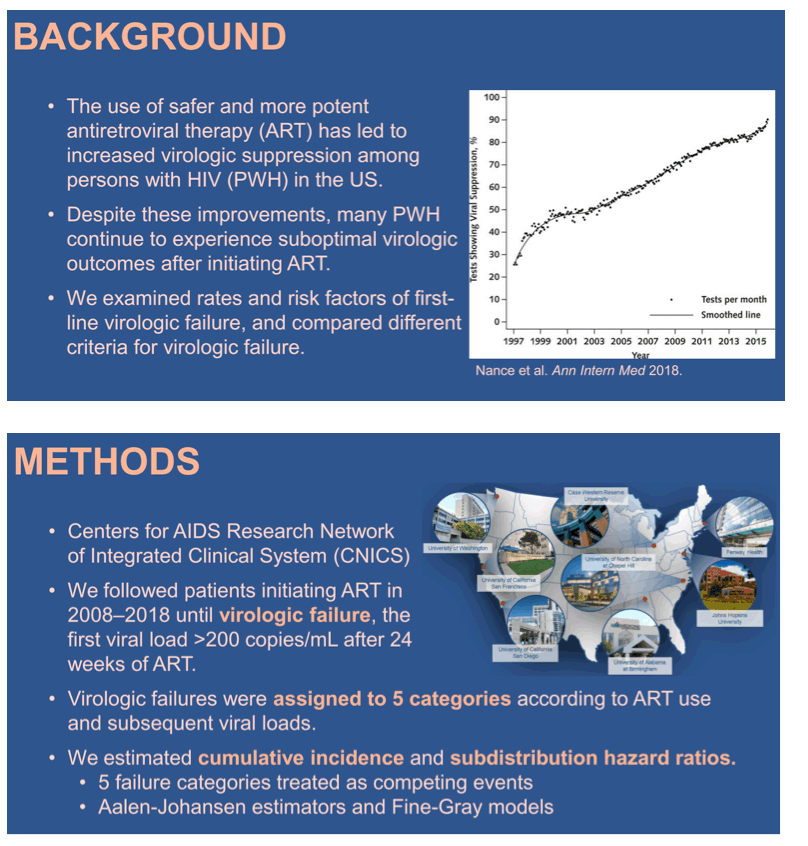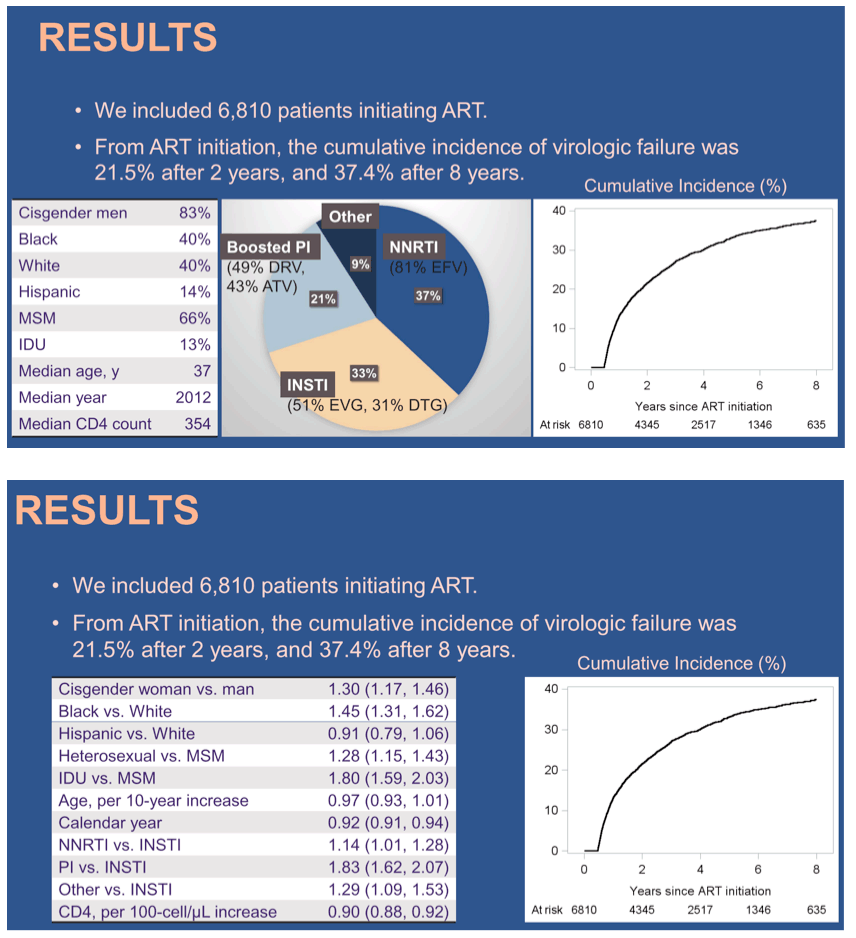 |
 |
 |
| |
CHARACTERIZING FIRST VIRAL FAILURES AMONG ANTIRETROVIRAL THERAPY INITIATORS IN THE US
|
| |
| |
CROI 2021 March 6-10 Reported by Jules Levin
Thibaut Davy-Mendez1, Sonia Napravnik2, David A. Wohl2, Ellen F. Eaton3, Richard Moore4, Edward R. Cachay5, Katerina Christopoulos1, George A. Yendewa6, Kenneth H. Mayer7, Mari M. Kitahata8, Joseph J. Eron2, for the Centers for AIDS Research Network of Integrated Clinical Systems
1University of California San Francisco, San Francisco, CA, USA, 2University of North Carolina at Chapel Hill, Chapel Hill, NC, USA, 3University of Alabama at Birmingham, Birmingham, AL, USA, 4The Johns Hopkins University School of Medicine, Baltimore, MD, USA, 5University of California San Diego, San Diego, CA, USA, 6Case Western Reserve University, Cleveland,OH,USA, 7The Fenway Institute, Boston, MA, USA, 8University of Washington, Seattle, WA, USA
program abstract
Background: Despite antiretroviral therapy (ART) improvements, some persons with HIV continue to experience suboptimal virologic outcomes. We examined reasons for first virologic failure in a large clinical population.
Methods: In 7 US clinical cohorts, 2008-2018, we estimated time from ART initiation to virologic failure (VF), defined as the first viral load (VL) >200 copies/mL after 24 weeks of ART. We assigned VF events to 5 exclusive categories according to ART use and subsequent VL (Fig. 1): 1) off ART for >30 days on VF date ("ART interruption"); 2) on ART + no confirmatory VL within 90 days ("unconfirmed VF"); 3) on ART + VL≤200 within 90 days ("short-term viremia"); 4) on ART + confirmatory VL>200 within 90 days ("confirmed VF without ART switch"); and 5) on ART + confirmatory VL>200 within 90 days + new anchor agent within 6 months ("confirmed VF with ART switch"). We used Aalen-Johansen methods to estimate cumulative incidence curves and Fine- Gray models adjusted for site to compare patient characteristics, treating each outcome and mortality as competing events.
Results: Of 6,810 patients (83% men, 40% Black, 40% White, median age 37 years), 37% initiated ART with an NNRTI (81% EFV), 33% an InSTI (51% EVG, 31% DTG), and 21% a boosted PI (49% DRV, 43% ATV), all in combination with 2 NRTIs. The overall VF risk was 21.5% by 2 years post-ART initiation (Fig. 1, top line). By 8 years post-initiation, 14.9% of patients experienced unconfirmed VF, 7.6% ART interruption, 6.6% short-term viremia, 5.8% confirmed VF without switch, and 2.4% confirmed VF with switch, or a total of 37.4% with VF for any reason (Fig. 1). Of 2,010 patients with VF, 24% had never achieved VL≤200 copies/mL. Overall VF rates were higher for women vs. men (sHR 1.30) and Black vs. White patients (sHR 1.45), and patients with lower CD4 counts at ART initiation (sHR 0.90 per 100-cell increase) [all P<0.05]. Associations varied by VF reason. Black vs. White patients had higher rates of confirmed VF with switch (sHR 1.99, 95% CI 1.33-2.98) but similar ART interruption rates. Patients on an NNRTI- [or PI-] vs. InSTI-based regimen had lower rates of unconfirmed VF (sHR 0.89, 95% CI 0.74-1.06), but higher rates of confirmed VF with switch (sHR 2.48, 95% CI 1.51-4.09).
Conclusion: One-fifth of ART initiators experienced viremia within 2 years. VF leading to an ART change was rare and more likely for patients initiating NNRTI- based regimens. Efforts to prevent viremia post-ART initiation should promote continuous ART and care engagement.




|
| |
|
 |
 |
|
|